Code, Commentary, And Standards For Design, Construction And Compliance
On Sept. 9th, 2022, the International Code Council published a press release announcing the publication of the 2021 International Tiny House Provisions.
Washington, D.C. – The International Code Council collaborated with the Tiny Home Industry Association (THIA), Modular Building Institute (MBI) and the Modular Home Builders Association (MHBA) to release the 2021 International Tiny House Provisions (ITHP). This innovative resource was created to provide a one-stop source for information on applicable codes and standards pertaining to tiny houses and how and when they may apply.
The Provisions Include:
- Model Legislation to Enable the Use of Affordable, Safe, Sustainable and Efficient Tiny Houses
- 2021 International Residential Code (IRC) with provisions from Appendix AQ (including commentary) incorporated and nonapplicable provisions removed
- ICC/MBI Standard 1200–2021, Standard for Off-Site Construction: Planning, Design, Fabrication and Assembly
- ICC/MBI Standard 1205–2021, Standard for Off-Site Construction: Inspection and Regulatory Compliance
- HUD Manufactured Home Construction and Safety Standards
The Publication Was Back-Dated To 2021
Note: It is important to note that the publication was back-dated to 2021 and the standards that are being promoted, ICCMB1 1200 and 1205 are American standards. They have removed all tiny house terminology after the disapproval at the 2024 hearing with the notion that tiny houses are ”inclusive”. The publication came out 6 days before the ICC/ASTM COTCO hearing addressing the duplication claim of ICC that objected to the COTCO approval of a new ASTM tiny house committee to develop and maintain standards specific to tiny houses. The main basis of the duplication claim was based on the two ICC/MBI standards 1200 ad 1205 that have removed all tiny house terms from the scope of the committee, the scope of the standards, and the body of the standards.
Why Is ICC Pushing Movable Tiny Houses Into Trailer Parks?
The ITHP includes provisions from the International Residential Code (IRC) with corresponding commentary; HUD manufactured housing standards that apply for movable tiny houses; ICC/MBI Standard 1200 and ICC/MBI Standard 1205 when tiny houses are constructed off-site; and model legislation for jurisdictions to ensure the safe and resilient deployment of tiny houses within their communities.
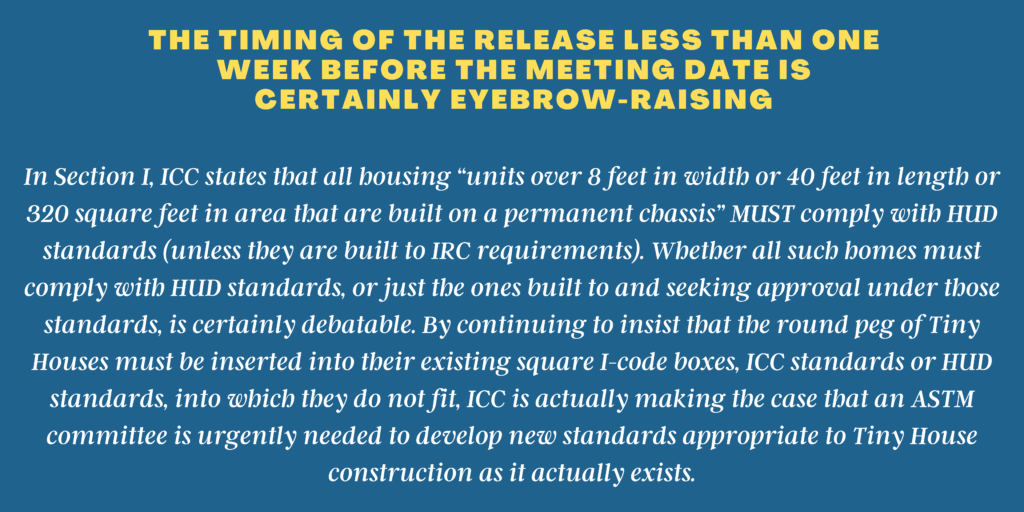
Eric Fried's Review Of ITHP From The Position Of A Local Building Official
Tiny Houses And The HUD Code
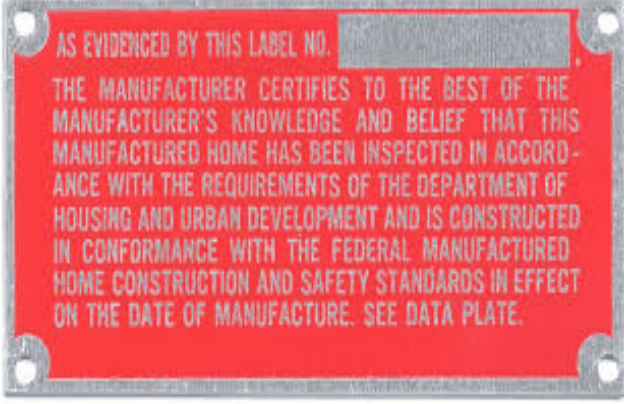
Tiny Houses On Wheels are NOT a manufactured home, although it could be built to the HUD code and marketed as a tiny house on wheels.
HUD Manufactured Home And Safety Standards: The National Manufactured Housing Construction and Safety Standards Act of 1974 (the Act) authorizes HUD, through its Office of Manufactured Housing Programs (OMHP), to establish and amend the Federal Manufactured Home Construction and Safety Standards (HUD Code) and the Procedural and Enforcement regulations, codified at 24 CFR parts 3280 and 3282, respectively. This authority authorizes
This authority authorizes HUD to issue and enforce appropriate standards for the construction, design, performance, and installation of manufactured homes—formerly known as mobile homes—ensure their quality, durability,affordability, safety. Since the HUD Code’s inception in 1976, Recreational Vehicles (RVs) have been largely exempted from the HUD Code.
Self-propelled RVs are statutorily exempted, and other classes of RVs which HUD maintains statutory jurisdiction have been exempted by regulations codified at 24 CFR 3282.8(g). Over time, the RV exemption has evolved.
Since codifying its regulatory exemption in 1982, HUD has exempted RVs from both HUD’s Manufactured Home Construction and Safety Standards at 24 CFR part 3280 and its Manufactured Home Procedural and Enforcement regulations at 24 CFR part 3282 if they are:
Built on a single chassis; 400 square feet or less when measured at their largest horizontal projections; self-propelled or permanently towable by a light duty truck.
HUD Response: As explained above, this rule does not regulate the use of manufactured homes or RVs but serves to expand the exemption for RVs, and to provide for a clear way of determining whether RVs that meet the statutory definition of a “manufactured home” are exempt from complying with HUD’s Manufactured Home Construction and Safety Standards and Procedural and Enforcement regulations.
The rule does not address “seasonal” or “permanent” occupancy or distinguish between RVs that are permanently placed in a park or campground and those being used to travel the county. This rule should not be used by RV parks to evict residents out of fear of legal consequences. “permanent” occupancy or distinguish between RVs that are permanently placed in a park or campground and those being used to travel the county. This rule should not be used by RV parks to evict residents out of fear of legal consequences.
HUD maintains statutory jurisdiction over the manufacture and installation of all structures falling within the statutory definition of “manufactured home,” but it elects not to regulate all structures that qualify for the RV exemption.
Because this rule does not prohibit or regulate the use of manufactured homes or RVs, including tiny homes, the secondary consequences described by certain commenters are moot, and HUD does not believe that there exists a need to address them individually.
International Building Code Hearing ( IBC )
The 2 ICC/MBI Standards 1200 and 1205 developed by the ICC Off-Site And Modular Construction Standards Committee (IS-OSMC) were disapproved at the IBC 2024 hearing and one reason was because tiny homes were included in the standards.
Currently all tiny house/home terms have been stricken from the scope of the committee, the scope of the standards, and the body of the standards. The committee blamed the disapproval on the tiny home terms, but actually Tom Hardiman, with the Modular Housing Institute and co-chair of IS-OSMC that presented at the hearing, stated he did not know how to answer the questions regarding tiny homes, and no one from the tiny house industry was present to answer the questions.
The standards were not well received by the code council. The code officials also stated the code has already covered many aspects that the standards were addressing. The definitions are too broad for off-site modular components. Precast elements are already addressed in the code. One commenter saw conflicts with certification already addressed in the code.
Micah Chappell City Of Seattle, State Building Code Council was the first to make a motion to disapprove the standards, he stated;
‘’ IRC Appendix Q is not required to be adopted by states or it is not required to be used, and tiny house is not defined in the IBC. This proposal would take the tiny house, which is just a dwelling unit, and take the review and application requirements of that dwelling unit and push it to a standard.
I do not agree with that. When we are talking about tiny houses and Appendix Q, they are very specific, but there are two criteria here that are not defined, a tiny house on wheels, or a tiny house like the other modular buildings where it is possibly driven in and then craned onto a foundation. So blanket items for tiny houses, I do not agree with. ‘’
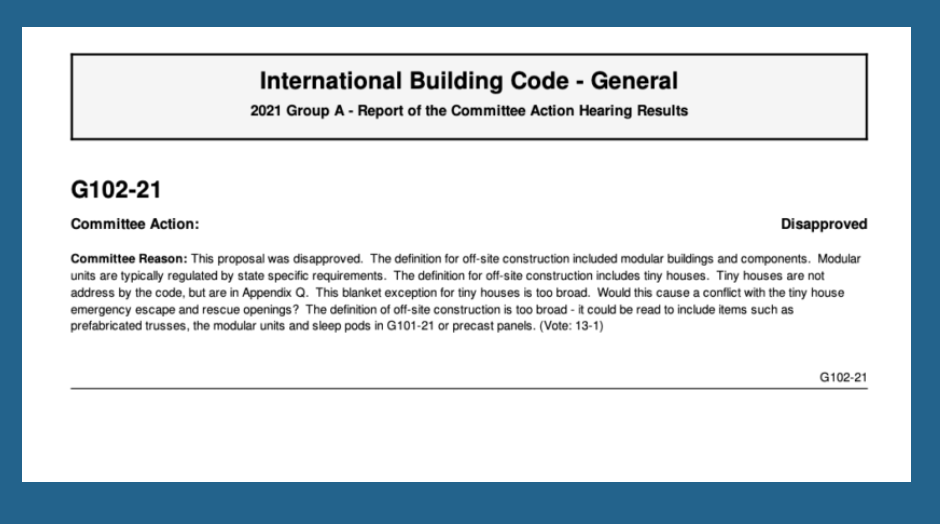
After the IBC hearing, the committee decided to remove all tiny home terms, along with Appendix AQ Tiny House from the scope of the committee, the scope of the standards, and from the body of the standards 100% with the theory that there was no need to call out tiny houses, because they were ”inclusive”.
Reasons For Disapproval At The IBC Hearing
- The definition for off-site included modular buildings and components. Modular units are typically regulated by state specific requirements.
- The definition for off-site construction includes tiny houses. Tiny houses are not address by the code, but are in Appendix Q.
- This blanket exception for tiny houses is too broad.
- Would this cause a conflict with the tiny house emergency escape and rescue openings?
- The definition of off-site construction is too broad-it could be read to include items such as prefabricated trusses, the modular units and sleep pods or precast panels.
ICC.MBI 1200 And 1205
ICC 1205 draft ballot approved:
Standard for Off–Site Construction: Inspection and
Regulatory Compliance
7/01/2021: Link
ICC 1200 draft ballot approved:
Standard for Off–Site Construction: Planning, Design,
Fabrication and Assembly
7/01/2021: Link
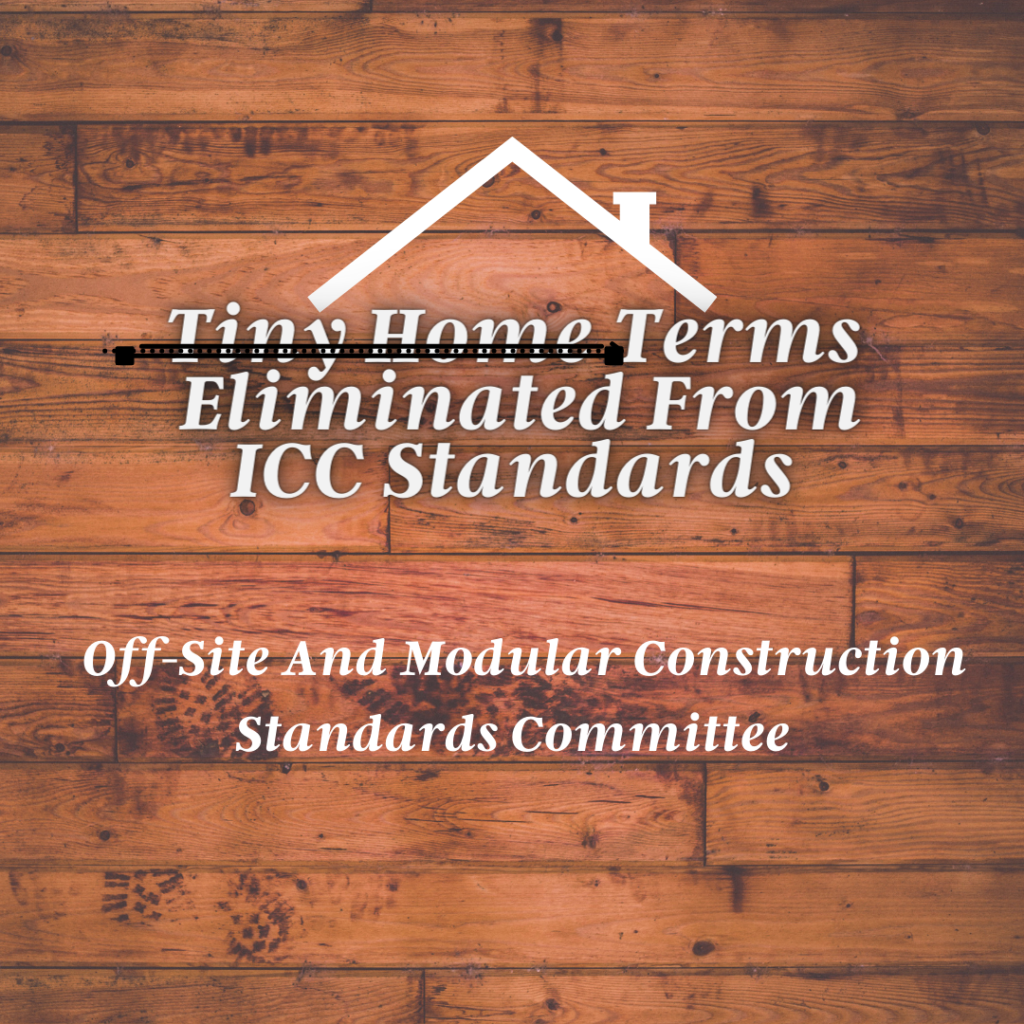
ICC/MBI Standards 1200 and 1205- Tiny homes were first excluded, then included, and because the proposal was voted down by the code council at the 2024 IBC hearing, all terminology of tiny homes has been stricken.
Reason: This Committee proposal deletes all mention of tiny homes in the ICC 1200 & 1205
Standards. Requirements for tiny homes are adopted by the AHJ, and should not be mandated by the Standards. AHJ may adopt IRC Appendix Q, but they may not. This will leave that decision up to them and not require it when the Standards are adopted.
Follow The History Of Tiny Homes In ICC/MBI 1200 and 1205 Standards
When Tom Hardiman, the co-chair of IS-OSMC was giving his opening remarks at the IBC hearing for 1200 and 1205 to be inclusive in the codes last year he mentioned there are 35 state agencies that have modular programs, and the 15 states that do not have a program, the local code official is the authority having jurisdiction ( AHJ ) for their projects.
He said ”You Could Imagine That Leaves Compliance And Quality Control Open To A Thousand Interpretations.” Tom mentioned that the goal was to gain uniformity.
Uniformity is the same goal that the tiny house industry has and the logic that tiny houses are inclusive in 1200 and 1205 without mentioning tiny house terms in the standards compounds the thousand interpretations times a thousand fold.
How many code officials, legislators, manufacturers, or consumers would interpret ICC/MBI standards 1200 and 1205 that would conclude tiny houses are ‘’inclusive’’?
One of the keys to writing standards with the goal of uniformity, is to establish agreed upon terms.
ICC/MBI Standards 1200 And 1205-Limitations Applied To Tiny Houses
- Both ICC/MBI standards are American standards meant to be adopted by jurisdictions in the US.
- Both standards are administrative in nature. Modular still must meet relevant building codes. The standards are also Off- Site Specific. We represent a lot of stakeholders who are do it yourselfers and have or will build their own tiny house on site. See ICC Off- Site Codes Working Group. Our ASTM activity would cover both on and off-site specifics.
- There is a limitation with the IRC, because the states are at different levels of ICC code adoption. You may have one state that’s on the 2009 codes, one that’s on 2015, and some that have adopted the 2018 or 2021 codes. There are also states that have their own codes. See International Codes-Adoption By State ( Jan 2022). Jurisdictions may or may not adopt codes and standards at the local level or will exclude an appendix. Appendix Q Tiny House ( 2018 IRC) and Appendix AQ Tiny House ( 2021) are not mandatory.
- Modular construction is one method of construction and is not an affordable solution for tiny houses on wheels because of the cost of all the required plans for each structure and the chassis, including architectural, mechanical, electrical, plumbing (mep) structural, and civil if attached to the soil.
- The tiny house industry does not desire to be broadly swept under modular construction and to be considered ‘’inclusive’’ by the ICC Off-Site And Modular Construction Standards Committee which lacks adequate representation of a broader group of stakeholders.
- There is a global housing crisis, and we need every viable solution that exists for housing. The ICC is not a regulatory body for a vehicular unit that is regulated by DOT and NHTSA, which applies to US regulations.
- ICC does not have the power or authority to police or enforce compliance with the contents of this standard. Only the governmental body that enacts this standard into law has such authority. The highlighted statement is directly from ICC-yet ICC is trying to enforce tiny houses to be in compliance with both standards against the will of a large portion of the tiny house industry that desires to develop standards specific to tiny houses with ASTM International and stakeholders in the tiny house industry.
- See statement under Maintenance- submittal of approval.
- The ICC codes and standards state they do not preclude other practices or methods of construction.( The ICC Objection is a contradiction to this statement) .
- Industrialized Housing: the standards define Industrialized Housing as- a residential structure that is designed for the occupancy of one or more families; is constructed in one or more modules, or constructed using one or more modular components, built at a location other that the permanent site; and is designed to be used as a permanent residential structure when the module or modular component is transported to the permanent site and erected or installed on a permanent foundation system. ( The potential ASTM standard for tiny houses on wheels will not be classified as an industrialized house or building that will comply to model building codes. In the US, it would be a vehicular unit that would comply to DOT,NTHSA regulations, and possibly regulated by HUD in the future. A tiny house on wheels could also be permanent or at a temporary location to be moved again).
- Off-Site Construction: The standards define off-site construction as- a modular building, modular component or panelized system that is designed and constructed in compliance with this standard and is wholly or in substantial part fabricated or assembled in manufacturing plants for installation—or assembly and installation—on a separate building site and has been manufactured in such a manner that all parts or processes cannot be inspected at the installation site without disassembly, damage to, or destruction thereof. ( The potential ASTM standard for tiny houses on wheels will not be designed or constructed in compliance to the ICC/MBI standards. )
- Compliance Alternative: The standards state- nothing in this standard is intended to prevent the use of designs, technologies or products, including listed and labeled modular components as alternatives to any prescriptions in this standard, provided that equivalence is demonstrated and approved by the author ity having jurisdiction. Listed and labeled modular components shall be installed in accordance with its listing, the manufacturer’s installation instructions and the applicable requirements of the construction codes adopted by the authority having jurisdiction. ( The ICC objection is preventing alternative and new methods for tiny houses ).
- Provisions that do not necessarily increase construction costs– ( We disagree with this statement in the standards, tiny houses built to modular construction, will raise the price.)
- Provisions that do not restrict the use of new materials, products or methods of construction- ( The ICC objection is trying to restrict a new method of construction and product).
- Provisions that do not give preferential treatment to particular types or classes of materials, products or methods of construction-( The ICC objection is trying to restrict a new classification and is promoting preferential treatment to tiny houses only built to Modular construction and or the HUD Manufactured Home And Safety Standards).
ICC Model Legislation
ICC co-authored Model Legislation for tiny houses that was published on the ICC website on May 4th, 2022 with a tiny house trade association promoting compliance to the IRC AQ Tiny House, and the 2 ICC/MBI standards 1200 and 1205.
There is a footnote regarding tiny houses and manufactured homes, that we do not feel is correct because of the HUD regulatory exemption in 1982. The Model Legislation States:
‘ Tiny houses on wheels with a permanent chassis over 320 square feet are subject to the Manufactured Home Construction and Safety Standards administered by the US. Department of Housing and Urban Development. Where these requirements apply, a manufacturer may opt-out if they then follow requirements equivalent to those contained in a model building code. ‘
At this time, HUD does not officially regulate tiny houses on wheels of any size. In the US, most tiny houses on wheels are built to RV standards, the 3rd party label would state compliance to NFPA 1192 or ANSI 119.5. If a tiny house was built to the Manufactured Home Construction and Safety Standards-it would be classified as a manufactured home, not a tiny house on wheels.
Also referencing the 2018 HUD final rule again that applies to the 320 square foot statement and HUD regulation of structures.
Over time, the RV exemption has evolved. Since codifying its regulatory exemption in 1982, HUD has exempted RVs from both HUD’s Manufactured Home Construction and Safety Standards at 24 CFR part 3280 and its Manufactured Home Procedural and Enforcement regulations at 24 CFR part 3282 if they are:
Built on a single chassis; 400 square feet or less when measured at their largest horizontal projections; self-propelled or permanently towable by a light duty truck.
The ICC claims that they have covered everything for tiny houses, including tiny houses on wheels yet in their own words, there are more requirements as stated in the model legislation:
‘While design and construction requirements are tied to the IRC, tiny houses with a chassis and wheels may also be subject to additional requirements to support their transportation.
In this case, additional certifications may be required.’
What I find interesting is that ICC has claimed to us and ASTM that tiny house terms are NOT needed in ICC/MBI 1200 and 1205, because they rationalize that tiny houses are inclusive of modular construction and do not need to be called out. But yet………they have to produce another supportive document-model legislation that adds the tiny house terms back so an authority having jurisdiction will understand that tiny houses are inclusive without the tiny house terms in the standards.
Supporting Freedom Of Tiny House Construction Methods
I personally support all construction paths for tiny houses, RV standards, Modular Construction, and even built to the HUD code.
Let the consumer decide what fits best for them with their budget, taste, and lifestyle in mind.
Tiny houses on wheels are mainly built to RV standards, and then RVIA has to lobby against the industry when they are associated with housing. Tiny houses on wheels can be built as a Modular, but that is not affordable with all the architectural, structural, MEP drawings fo the structure and chassis for each unit built. We appreciate that we can build to the HUD code, but we want to develop and standardize our own industry, create a new classification, and not be swept under the requirement and regulations of established industries.
There are different barriers to zoning, financing, code enforcement, and perceptions for all the different types of housing.
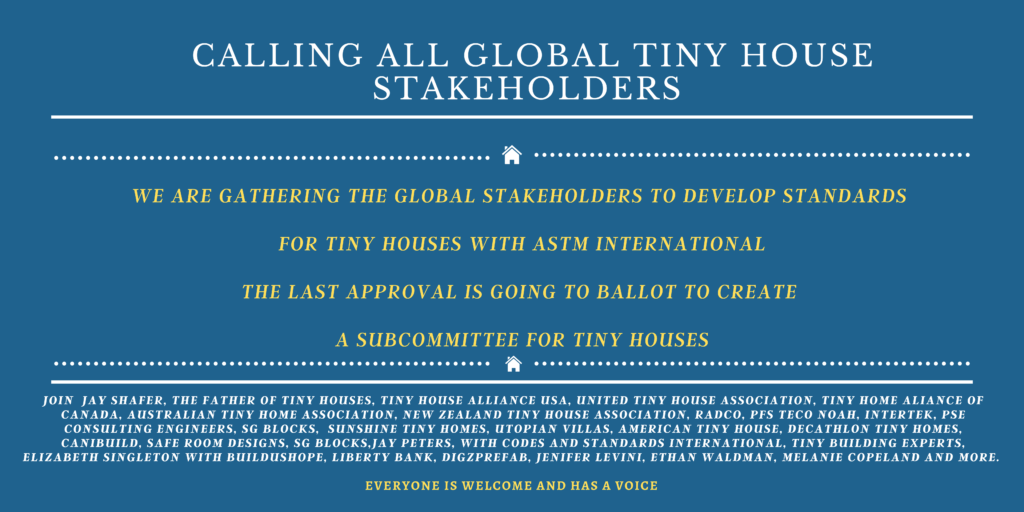
Related Blog Posts
ASTM Tiny House Subcommittee Goes To Ballot Under E6
Jay Peters Consultant For ASTM Tiny House Consultants
ICC Model Legislation For Tiny Houses

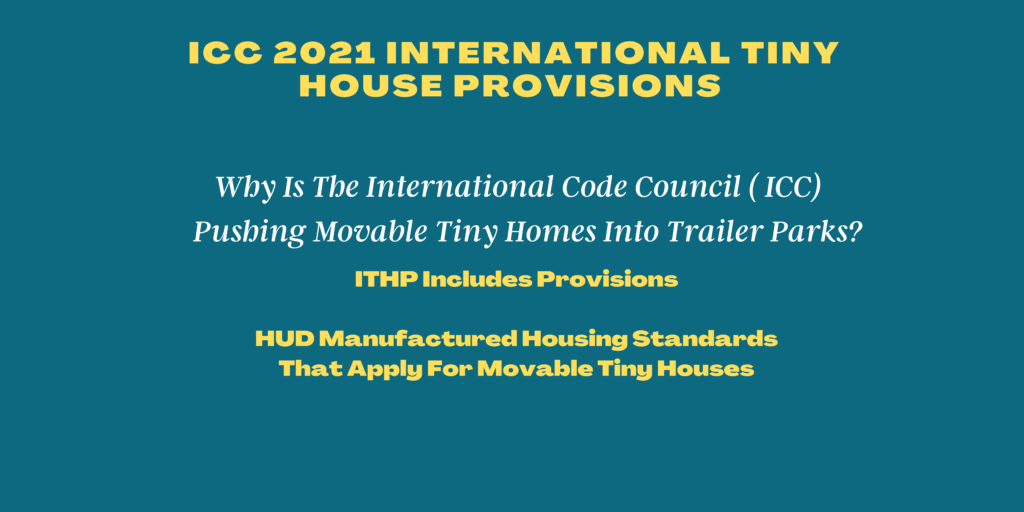
From an international perspective the standards referred to in ICC are US standards and are not relevant to the tiny house industry in Austrlalia who use Australian and New Zealand standards and ASTM standards. So not relevant outside the US.